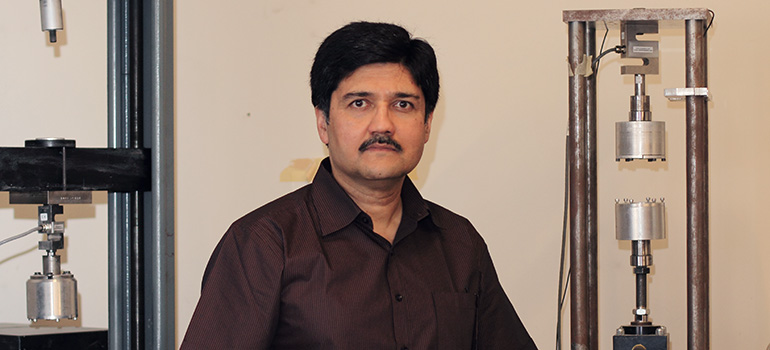A Canadian-engineered pavement technology that has withstood five South Asian monsoon seasons with flying colours holds significant promises for revolutionizing road and building infrastructure in Canada and all over the world.
Pioneered by the Canada-India Research Centre of Excellence IC-IMPACTS , which is headed by UBC Department of Civil Engineering professor Dr. Nemy Banthia, this pavement material’s financial, functional, and sustainable advantages have begun to help modernize India’s infrastructure.
Compared with traditional concrete, this material’s unique inclusion of fibres that allow for the pavement to be very thin makes it cheaper to produce. It is also more durable, and with 60% of the cement replaced by fly-ash that is a byproduct of local thermal power plants, it contributes to local sustainability efforts. Reduction in cement consumption is an urgent global need as cement production is responsible for over 5% of global green-house gas emissions.
Even so, it took a while for India to fully embrace the new technology.
“This is not like IT, which changes very rapidly,” Banthia said, “safety is of paramount importance, and these [infrastructure] industries don’t change as rapidly, and we always struggle with being ahead and trying to convince industry to trust us with these new materials. Industry tends to be conservative.”
First used in the rural Indian village of Thondebhavi five years ago, the product is now available for use in India and a large consortium in India is planning two major 10-km road projects slated for completion after the pandemic.
Given the material is fibre-enforced concrete, it holds limitless potential for application in everything, from dams and bridges to buildings and public facilities.
Despite being Canadian-engineered, the material was only introduced to the Canadian market last year—and with numerous adjustments. Dr. Banthia and his team modified the properties to handle the colder climate, added cellulose fibres with advanced self-repairing capability and included scraps of tire fibres to further improve sustainability.
The new version of the material is currently being tested in a parking lot in Chawathil First Nation near Hope, BC.
Dr. Banthia is particularly excited about the global implications of the new material. If it gains traction, it would help Canada broaden its global influence as an engineering powerhouse.
“Civil infrastructure plays a critical role in making communities healthy, livable, and prosperous. UBC and IC-IMPACTS are committed to bringing advanced technologies to First Nations, rural and other communities through respectful partnerships,” said Dr. Banthia.
To read the full Business in Vancouver article, click here.
